
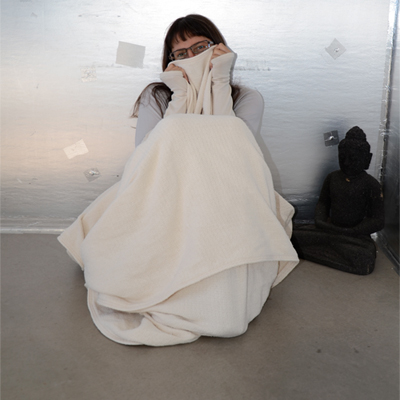
Using Emotional Freedom Technique (EFT), the Gupta Amygdala Retraining™ Program, the Dynamic Neural Retraining System™, deep creative visualization, and a drastic reduction of EMF exposure, I have managed to make serious headway on healing my severe fabric sensitivity that, at one time, left me naked in my apartment for a whole week with only a small shawl to wrap around me and required extensive clothes-boiling and washing procedures for every item of clothing which exhausted me day after day.
The Challenge
For the past 6 or so years, after becoming disabled by chemical sensitivity in 2004, I developed a sensitivity to most fabrics – naturals like organic cotton, pure wool, and organic silk included – so severe that I had to sit in my apartment naked for a week in 2008, drive across country from Florida to Arizona in a bathing suit, and sleep for years on a hard, cold tile floor with only a pillow. That’s right, no sheets, no blankets, no comforter to keep me warm. I relied on gallon glass containers filled with hot water and held between my legs as I slept, and later, Cadet and Fahrenheat heaters, to be my blankets. I had no socks, no underwear, no hats, no gloves to contain the heat in my body, only thin leggings and T-shirts. The few pieces of clothing I did tolerate, I could not wash or I chanced “contaminating” them and no longer being able to wear them. So I have essentially been wearing dirty rags for the past 4 years. Yes, I live in sunny Arizona, but in a northeastern mountain community where nighttime temperatures drop year-round, down to zero or below in winter. Because of my lack of proper clothing or bedding, I’ve had to use a heater in my bedroom at night year-round. Even though over the years my body has adjusted to being near naked in colder temps, my mind has not. I yearn for thick, colorful wool sweaters, stylish winter coats, and a firm mattress dressed in beautiful taupe sheets, comfy, plush blankets and piled high with fluffy pillows. I want to read in bed, lounge about all day in my silky organic bedding, snuggle with my beloved while we watch movies on a cold winter day with steaming hot chocolate and a bowl of split pea soup and garlic bread by our side.
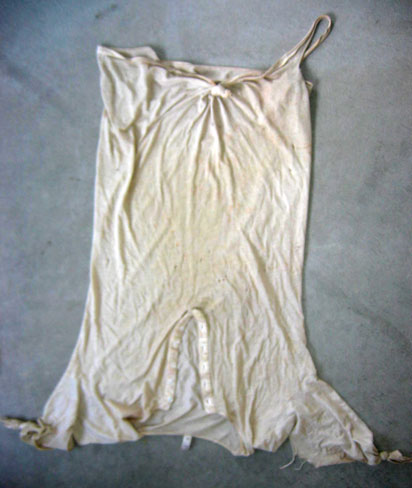
First things first. I promised myself this summer that I would not be going through this winter without warmer clothes or blankets. I did so knowing I had some important new tools to help me manifest this vision; EFT, brain retraining, and creative visualization. I had been using the Gupta Amgdala Retraining™ Program and Annie Hopper’s Dynamic Neural Retraining System™ (DNRS™) – both based primarily on neurolinguistic programming (NLP) – for the past year or two. I never applied myself 100% to either program, only doing the exercises sporadically (a few weeks here, a few weeks there), and thus saw minimal symptom improvement – nothing lasting or clear-cut. So what made me think things could be any different this year?

Getting to the Root of the Matter
It was an offhand comment by a Planet Thrive community member that started my path toward fabric sensitivity recovery. We were discussing chemical sensitivity in the Planet Thrive forum, and he did not understand why I would react to organic cotton, wool, and silk. His idea about chemical sensitivity was that one would only react to toxic chemicals. He asked what happened to make me reactive to those natural materials. I got defensive, and pointed out how many others with environmental illness have a fabric sensitivity and also have trouble with organic cotton and wool. But he insisted that they were probably reacting to unlabeled synthetic chemicals used in processing. I got even more defensive. I brooded over his questions the next few days. What right did he have to question my version of chemical sensitivity? I didn’t choose my triggers; they chose me, after all.
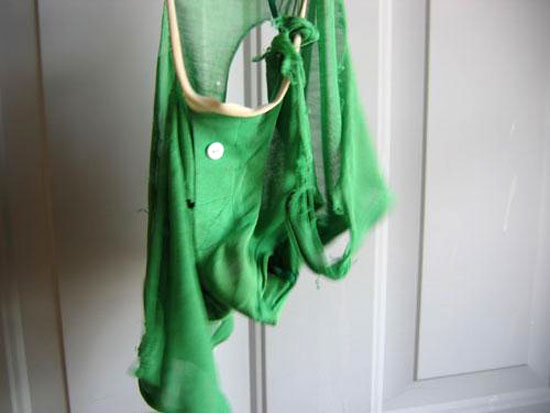
I got to thinking about the circumstances surrounding the time period during which I sensitized to organic cotton, wool and silk. I was living in my NYC West Village studio. I didn’t know I was chemically sensitive yet, but I knew I was having major health issues. I wrote to Natural Home Magazine to see if their healthy home interiors expert would give me advice on how to clean up my home environment. Cheryl Terrace came and interviewed me and one of her suggestions was to get a wool bedding system. I ordered a comforter and loved it. I slept with it a month and then decided to splurge and get a wool mattress topper and wool pillows as well. But I never got to sleep in my new wool bedding system. The day I got it all, I sensitized to it. So much so, that I had to pack it all up tightly and put it in my closet. After that, I could no longer wear any of my wool clothing – not my beautiful navy merino ribbed turtleneck nor my favorite organic wool scarf that I had knit myself the year before. Being around wool now caused a weird fluttering in my thyroid area and respiratory distress. The same thing happened with silk. I bought a pair of expensive organic silk long johns and was never able to wear them. When I got near silk or wool, it felt like every cell in my body started quivering. If I tried to ignore it and push through the symptoms, the situation would just escalate to even more distressing and severe symptoms.
Discovery of Toxic Mold
Then in June, 2005, after I had been fully disabled by severe environmental illness, I got rid of my regular cotton futon and bought a new organic cotton futon in a further effort to clean up my lifestyle. I did okay the first few weeks, but then suddenly found myself reacting to the futon. Meanwhile, it started to get real humid and I had increasing respiratory symptoms in my apartment. An MCS friend helped me have one of my “lightbulb moments.” A survivor of toxic black mold, she had been encouraging me to read Ritchie Shoemaker’s Mold Warriors. Mold was not my problem but she didn’t give up. She kept raising the issue during our talks. Finally I put two and two together – I must have a toxic mold infestation in all of my musty closets; in 2003, there had been a flood in the apartment above me. My entire ceiling came down, along with 2 feet of water. My landlord rebuilt my ceiling and I was back in my apartment within two weeks. What I didn’t realize, is that they did nothing to replace the non-visible areas of the apartment; all the closet ceilings were left soaking wet and ripe for mold growth. In fact, there had been flooding in several apartment lines in my building and what I did not know is there was visible black mold in other tenants’ apartments. I had been living in a sick building for years.

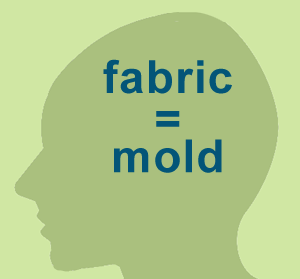
What Fires Together, Wires Together
So what I was about to put together is that while I was being injured by toxic mold and my brain was in a highly sensitized state, I was also exposing myself to a lot of new materials (wool, organic cotton, silk) that I had never really used in large amounts before. In addition, all of my clothes and bedding had become contaminated with mold – tests showed they were covered with a fungus. My layman’s theory is that my limbic and immune systems became so confused, that they cross-wired fabric with mold. So now my body thought any fabric that touched my body was toxic and mold-ridden, even if it was not.
Realizing this is what might have happened to me was a huge step forward in treating the problem. I realized that instead of spending my focus and energy on “preparing” my clothes – which entailed hours upon hours of boiling items one at a time in a pot outside and then washing them over and over again in my washing machine – that I should instead focus on rewiring my response to fabric. The external trigger was not my problem! The problem was inside my brain.
Adapting an OCD Exercise
This theory was in alignment with an Obsessive Compulsive Disorder (OCD) treatment shared in the Norman Doidge book The Brain that Changes Itself. I had heard about the book from Annie Hopper, who had recovered herself from severe MCS and EHS using brain plasticity exercises. In the book, Dr. Doidge shares that OCD involves three parts of the brain: the orbital frontal cortex, the cingulate gyrus, and the caudate nucleus. All of these are hyperactive in OCD brains, as shown by PET scans. Dr. Doidge says OCD is a type of “brain lock.” The exercise he shares unlocks the link between the orbital cortex and cingulate to normalize function of the caudate. This requires a manual shift by having the patient focus their attention on something besides worry; to use an enjoyable activity to interrupt the obsessive thoughts and behaviors, strengthening new circuits while weakening old pathological ones. Although chemical sensitivity is not OCD, the limbic system seems to be stuck in some sort of similar “brain lock,” so it felt like it could be beneficial to re-interpret this exercise for my situation.
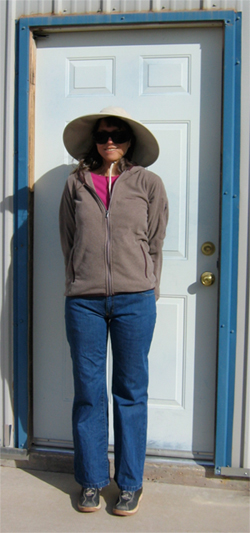
The three steps in this exercise are to relabel, remind and refocus. If we apply this to chemical sensitivity it looks like this:
1. Relabel. The first step is to identify the problem as one of the brain, not of external triggers. The problem is not a “toxic” chemical or other offending trigger, but an impaired limbic system. In the case of my fabric sensitivity, I was able to see clearly that my brain and immune system had cross-wired fabrics and mold together.
2. Remind. You then must remind yourself that if the chemical sensitivity does not resolve, it’s because there is a “faulty circuit” and you should look at physical proof – test results like brain scans, for example – that show these faulty circuits and the increased electrical activity in these parts of the brain. I didn’t have any test results to act as proof, but I was able to remind myself that most people – both with chemical sensitivity and without – are able to wear clothing, and thus point out that I had some faulty wiring in my brain that was affecting sensory input interpretation.
3. Refocus. The third step is to divert your attention to a positive, enjoyable activity – something you can concentrate on wholly for 30 minutes, allowing the old circuit to be bypassed and rerouting your body’s unconscious response to outside stimuli. That means when you are reacting to a trigger, try doing something fairly simple and pleasurable, and easily achievable, like gardening, listening to music, knitting, drawing, kicking a football, playing an instrument. When you focus on this new activity, you are actively constructing new brain circuitry. When you shift your attention like that regularly, it changes your brain wiring and overrides your symptoms. This can take a few weeks to a few months.
With all this in mind, here is how I approached my recovery from fabric sensitivity:
My approach
I started by doing twenty private Emotional Freedom Technique (EFT) sessions with Lisa Snow, who has a strong grasp of using EFT for food allergies and chemical sensitivities. We worked on physical triggers like wool, cotton, and silk. But also on the anxiety and emotions my body associated with becoming sensitized to those things. The process of becoming severely disabled by chemical sensitivity can be highly traumatizing – who wouldn’t be upset when their entire world becomes hostile to their survival almost overnight, and all of their support systems dissolve away just as quickly?! Working on the trauma end of things is just as important as working on the physical triggers. I needed to grieve for the girl who slept with her head inches away from a toxic mold infestation, sleeping in clothes and bedding covered in fungus. I had to release my emotional reactions to all the losses – the budding copywriter career, my NYC friends and social network, my clothes, camera, art book collection, my ability to eat and enjoy food, my health, my security, my identity, my future. I had to calm my nervous system and cellular response to the mere thought of organic cotton and wool.
During this time, I also continued to do both the Gupta and Hopper brain retraining exercises. But I didn’t start to see real improvements until after I drastically curtailed my computer time online, after which there was a significant increase in my brain’s ability to be rewired using the brain retraining exercises. I was then able to use the DNRS™ exercise and visualization practice to work on individual clothing items. I did this while walking up and down my dirt road outside, each time wearing a piece of new clothing that I did not yet tolerate. There was something about walking while doing the exercises that helped my brain to be able to engage in a deep visualization exercise that was previously quite difficult for me.
So I now have underwear, socks, bras, t-shirts, mini-skirts, summer dresses, organic cotton corduroys, organic hemp denim jeans, and 3 wool sweaters I can use, that I didn’t have before the summer. I am beyond ecstatic.
Here is what my process looked like, shared in a way to help you apply it to your own situation:

1. Determine what neurotoxic injury occurred around the time of your fabric sensitization (e.g. mold exposure, lyme disease, chemical injury, emotional trauma);
2. Relabel, remind, refocus. Keep reminding yourself that your reactions are due to faulty wiring in your brain; not to any one trigger. Your washing machine is not “contaminated.” Your organic cotton towel is not “toxic.” Be sure to adjust your language to reflect this new paradigm.
3. Use EFT or a similar modality to work on calming the nervous system response to both the fabric triggers and the original neurotoxic injury, including any emotional trauma connected with either of them;
4. Reduce any major toxic load you are experiencing as much as possible; whether that is a high EMF load, consistent exposure to toxic chemicals, an underlying bacterial infection, a stressful relationship, etc.
5. Commit to a daily brain retraining practice using either the Gupta Amygdala Retraining Program or the Dynamic Neural Retraining System, or both.
6. Make use of creative visualization and other distracting activities during exposures to help create new neural responses to triggers.
7. Celebrate your successes and let them fuel your confidence to expand your horizons even further!
Reducing EMF Load Critical to My Success
I must also emphasize that I attribute a significant portion of my healing to the fact that I had to drastically curtail my use of the computer during this time, because it was hurting my EMF-sensitive boyfriend. I use my computer for many things: for research, online shopping, socializing, entertainment, and my blogs. About two months ago when we first realized the problem, I had to immediately stay offline all day except for a few hours at night, to avoid hurting my boyfriend. I developed a two week migraine after going cold-turkey into this new computer schedule; a form of withdrawal, or detox, from being exposed to all that EMF every day. Once the migraine passed, I started seeing an overall ease at applying the brain retraining exercises to clothing and other objects that were triggering me. I still needed to do the brain retraining, but saw improvements much more easily and quickly than in the past. It really felt miraculous!
In Summary
I wanted to share my progress and ideas about why I am seeing success lately, in case it might help others with severe fabric sensitivity to figure out how to tackle their own challenging intolerances. I can’t tell you what a relief it is to have several pairs of socks and underwear, to have some warmer clothes for the winter, to be able to wash my clothes between wearings (yes!), and to, most of all, have HOPE for total recovery from MCS and a well future.
Yes, I still have a ways to go. I am still reacting to organic cotton blankets. But I feel extremely confident that I will eventually be able to sleep on a real bed with a mattress and bedding, wear whatever clothes I want to with minimal preparation, and all this will be a distant surreal memory. I have the tools I need to conquer this, as well as the persistence and commitment to keep at it. And an unwillingness to settle for anything less than health, wellness and freedom in my life.

© 2011 Julie Laffin
I just want to encourage anyone challenged with fabric sensitivity to look back in their history to see what might’ve been happening at the time they sensitized to fabrics. Becoming conscious of a mold connection or other type of neurotoxic injury, or even just an emotional stressor, can be the first step to unraveling your puzzle. Reducing any major toxic loads in your life is another important step in reducing neural inflammation and helping the brain become more available to the improvements that brain retraining can bring. Good neuro-nutrition – supplying the brain with essential fatty acids and neurotransmitter precursors – is also vital.
The tools are out there to conquer this, with a bit of ingenuity and persistence, and I am sure that you can find yourself wearing clothing again in time. I’m doing it – you can do it, too!
Note: One thing I’d like to mention, is that I have lived chemical free for at least five years now. That means no products with chemicals for cleaning or personal care. It also means chemical free foods – only organic, wild, grass-fed, free-range, antibiotic-free, etc. I have also lived a low-EMF lifestyle. No cell phone, no cell towers, no WiFi, no cordless phones, no Blackberry, no iPhone, no Smart Phone, no Smart Meter, etc. No doubt this strong lifestyle foundation is what enabled all the other practices and improvements to take place.
Disclaimer: The above process is what worked for me personally. The ideas and layman’s theories expressed are just my opinion based on my own personal experience; this is not a scientifically proven approach to recovery from fabric sensitivity. Each person’s situation is unique. Please keep all this in mind if you decide to attempt a similar program for your own situation. There is no guarantee what worked for me will work for you. Please review any change to your health care treatment plan with your physician before proceeding. If you choose to take exposure risks similar to those I mention above, please take small risks and never purposefully expose yourself to severe triggers during any retraining program. Until your neural networks are fully rewired to healthy pathways, you will continue to experience the severe reactions. Use common sense and care.










i haven’t read this yet, theres a lot to read, but I’ve noticed that when i think of touching new clothes I’m washing to clean out toxins, i get the symptoms, just thinking of it ! fear is a strong thing
Julie, your recovery is incredibly inspiring, and gives me hope. Thank you.
I just discovered this article and wish I’d found it sooner. I’ve been dealing with severe fabric sensitivity, paper sensitivity the past seveal months. I was overexposed to mold in a couple of places I’ve lived. It seems I developed a severe mold allergy, which I was always sensitive to anyway and some chemical sensitivity. Your essay really resonates with me. What was the test you used to find mold on ypir clothes?
I’ve slept on tne floor too, as i was reacting to sheets. I cannot wash my clothes without them getting contaminated, I can’t wear them on my body without some itching or even burning sometimes. I long to wear the clothes I love without so much evgort to get them clean. How did you get to wear your clothes for so long without washing them? My entire living space became contaminated. I was told to discard all my belongings and move. We don’t have all the answers as to why this was happening. I’m not sure if discarding everything was the answer, nut thete is little to no help out there for this. It’s such a horrible and traumatic experience to go through. And an isolating one. I’m also experiencing a lot of emf sensitivity and can’t use a phone or computer for long. I know it’s been a while since you went through your ordeal, it’s so promising to hear of your recovery. Would you be able to email me,would like to be in touch with you about your progress.
Thanks! Take care,
Claudia
Hello Claudia,call me Cocoabrown, it seems we have a lot in common. I too have severe clothes allergies and emf and almost everything I put on my skin severely burns it and I cannot use my washing machine at the moment.
I think the dr Beckmann washing machine limescale descaler that I used to use is no longer tolerable as even after washing it out with water and bicarb soda and even vinegar I currently cannot stop it from causing my clothes that I washed in there since using the descaler to stop burning my skin. I have re-washed those clothes that were ok before using the descaler in the machine a lot and still cannot stop them from burninn my skin. I have had this skin problem for around 20 yrs with clothes which has gotten worse overtime and I am seriously running out of things to wear.
I wish I had kept some of my old clothes that I gave away to charity shops last year and before that didn’t fit before me for some yrs as now I have lost weight and would have been able to wear them. I can’t even be in my house at the moment as something like maybe wi fi coming from my new neighbour above or something gives me severe painful tinnutis and head crushing headaches so severe and painful it feels like a clamp is continuously squeezing the life out of my head. Even to hold a mobile in my hand hurts it much less before using it. I even bought Annie Hopper’s dvd programme a few months ago and was only able to watch a couple of hrs of it as the dvd gave me a severe migraine so at the minute they are just gathering dust when sadly that programme could be helping me if only I was able to watch.
I have tried rewashing and soaking clothes like Linda Sepp has suggested on her website who has severe mcs aswell but that hasn’t helped as yet.Everything irritates and severely burns my skin like acid is on my skin or something and this problem also occurs inside with severe internal burning and inflammation all over that moves around everywhere all the time and even in my head a lot since these new symptoms with deadly headaches and tinnutis over the last couple of months. I also suffer form severe endometriosis feeling unwell and weak a lot and have psoriasis on my scalp,acid reflux along with a hiatius hernia and other health problems. I will have to continue my story at a later date. Caludia please kindly give me an update on how you are currently doing and how you have been coping with your mcs to clothes and your emf symptoms. I too also have problems with beds matresses sheets and a lot of other things on my skin that severely burn and irritate it. It is really hard and isolating at times-feels like we are going crazy at times to say the least…You can e-mail me at [email protected]. Also if there is anyone that can offer me any help or suggestions to my problems please feel free to also e-mail me.
Kindest regards to all,
From Cocoabrown.
I see you don’t monetize your page, don’t waste your traffic,
you can earn extra cash every month because you’ve got hi quality content.
If you want to know how to make extra $$$,
search for: best adsense alternative Wrastain’s tools